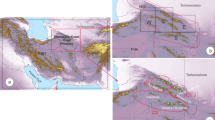Abstract
Sedum plumbizincicola X.H. Guo et S.B. Zhou ex L.H. Wu (Crassulaceae), a new species restricted to lead–zinc mining areas in Zhejiang Province, China, is described and illustrated. This taxon belongs to sect. Sedum (H. Ohba) S.H. Fu based on the adaxially gibbous carpels and follicles. It superficially resembles S. alfredii Hance and three other Sedum species found in the same area, but differs from these other taxa in bearing 4-merous flowers. Differences in geographical distribution, growth habit, phenology, macromorphology, leaf and stem anatomy, as well as seed micromorphology among S. plumbizincicola, S. alfredii and other related taxa in the genus Sedum are also reported. nrDNA internal transcribed spacers (ITS) sequences from seven populations of S. plumbizincicola support the recognition of this as a taxonomic entity distinct from S. alfredii.






Similar content being viewed by others
References
Altschul SF, Gish W, Miller W, Myers EW, Lipman DJ (1990) Basic local alignment search tool. J Mol Biol 215:403–410
Berger A (1930) Crassulaceae. In: Engler A, Prantl K (eds) Die natürlichen Pflanzenfamilien, vol 18A, 2nd edn. Verlag von WEngelmann, Leipzig, pp 352–483
Carrillo-Reyes P, Sosa V, Mort ME (2009) Molecular phylogeny of the Acre clade (Crassulaceae): dealing with the lack of definitions for Echeveria and Sedum. Mol Phylogenet Evol 53:267–276
Felsenstein J (1985) Confidence limits on phylogenies: an approach using the bootstrap. Evolution 39:783–791
Fu KT (1965) Species et combinaciones novae Crassulacearum sinicarum. Acta Phytotax Sin 10:111–128
Fu KT (1974) Revision of the section Oreades of Chinese Sedum. Acta Phytotax Sin 12:51–77
Fu KJ, Ohba H (2001) Crassulaceae. In: Wu ZY, Raven PH (eds) Flora of China, vol 8., Brassicaceae through SaxifragaceaeScience Press, Beijing and Missouri Botanical Garden Press, St Louis, pp 202–268
Griffin HG, Griffin AM (1996) Lasergene from DNAStar offers a comprehensive sequence analysis package. Mol Biotechnol 5:184
He YQ (1993) Sedum L. In: Flora of Zhejiang. vol 3, Science Press of Zhejiang, Hangzhou, pp 73–84
Hellwig FH, Nolte M, Ochsmann J, Wissemann V (1999) Rapid isolation of total cell DNA from milligram plant tissue. Haussknechtia 7:29–34
Jiangsu Institute of Botany (1982) Flora of Jiangsu, vol 2. Science Press of Jiangsu, Nanjing
Jiangxi Institute of Botany (2004) Flora of Jiangxi, vol 2. Science Press of Chinese, Nanchang
Jin XF, Qian L, Lu YH, Zhang HW, Wang HZ (2008) Seed micromorphology of Sedum (s.l.) from Zhejiang and its taxonomic implications. J Zhejiang Univ (Agric Life Sci) 34:409–417
Li N, Chen KL, Liu Z, Ye CJ, Chen SL (2010) Identification of medicinal plants from genus Sedum based on DNA bar coding. World Sci Technol Mod Tradit Chin Med Mater Medica 12:463–467
Nei M, Kumar S (2000) Molecular Evolution and Phylogenetics. Oxford University Press, New York
Praeger LR (1921) An account of the genus Sedum as found in cultivation. J R Hort Soc 46:1–314
Stern WL, Judd WS (2002) Systematic and comparative anatomy of Cymbidieae (Orchidaceae). Bot J Linn Soc 139:1–27
’t Hart H (1991) Evolution and classification of the European Sedum species. Fl Medit 1:31–61
’t Hart H, Bleij B (2003) Sedum. In: Eggli U (ed) Illustrated handbook of succulent plants: Crassulaceae. Springer, Berlin, pp 235–332
Tamura K, Peterson D, Peterson N, Stecher G, Nei M, Kumar S (2011) MEGA5: molecular evolutionary genetics analysis using maximum likelihood, evolutionary distance, and maximum parsimony methods. Mol Biol Evol 28:2731–2739
Thiede J, Eggli U (2007) Crassulaceae. In: Kubitzki K (ed) The families and genera of vascular plants, vol IX. Springer, Berlin, pp 83–118
Wu LH, Zhou SB, Bi D, Guo XH, Qin WH, Wang H, Wang CJ, Luo YM (2006) Sedum plumbizincicola, a new species of the Crassulaceae from Zhejiang. Soils 38:632–633
Wu HJ, Xu R, Wan DR, Chen Y (2008) Genetic diversity analysis on the medicinal plants of Sedum L. by RAPD. J Huazhong Agric Univ 27:782–786
Xue ZW (1986) Sedum L. In: Flora of Anhui, vol 2. Chinese Forecast Press, Anhui, pp 498–511
Zheng Y (1997) A pollen morphology study on twelve species of Sedum in Anhui. Bull Bot Res 17:158–162
Zheng Y, Gong J (1999) A leaf epidermis study on twelve species of Sedum in Anhui. Bull Bot Res 19:292–297
Zheng Y, Gong J, Liu DY, Jiang Y, Xu YM (2001) Anatomical studies on stem of Sedum from Anhui Province. J Anhui Normal Univ (Nat Sci) 24:239–242
Acknowledgments
This research was supported jointly by the International Scientific Collaborative Programme of the Ministry of Science and Technology of China (2010DFA92360), the National Natural Science Foundation of China (40821140539, 40871155), and the Program of Innovative Engineering of the Chinese Academy of Sciences (KSCX2-YW-G-053). A grant from Anhui Normal University is gratefully acknowledged. We extend special thanks to research scientists Xiao-quan Wang and Xian-zhao Kan. We thank Xia Pan, Jing Ren, Jie-xue Huang, Feng-jiao Nai, Li-ke Cheng, Li-qiang Zhou, Qi Luo, Ying Wang, Gui-jun Wang, Benqi Yu, Jinrong Hu, Jinghua Li and Naidong Chen for useful discussion regarding populations, habitat, and conservation. We also thank Dr S.A. Harris, Curator of the Oxford University Herbaria, UK, for helpful advice and discussions.
Author information
Authors and Affiliations
Corresponding authors
Rights and permissions
About this article
Cite this article
Wu, L.H., Liu, Y.J., Zhou, S.B. et al. Sedum plumbizincicola X.H. Guo et S.B. Zhou ex L.H. Wu (Crassulaceae): a new species from Zhejiang Province, China. Plant Syst Evol 299, 487–498 (2013). https://doi.org/10.1007/s00606-012-0738-x
Received:
Accepted:
Published:
Issue Date:
DOI: https://doi.org/10.1007/s00606-012-0738-x




